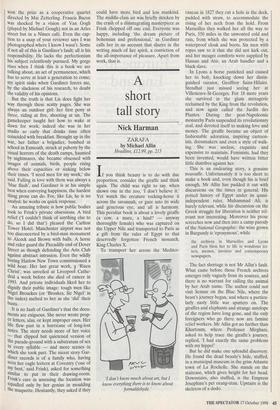A perfectionist in the wilds of Bohemia
David Hughes
FRINK by Stephen Gardiner HarperCollins, £24.99, pp. 326 When in 1972 Elisabeth Frink suggest- ed 'doing my head', as she put it, I carried my bonce proudly around the Languedoc, wondering whether I could afford to insure it. At our next convivial lunch for the usual half-dozen or more — her agile hands shaped powerfully flavoured meals as if modelling them at speed — she failed to refer to my head. Thinking of her style, I tried hardening my jaw at table, looking balder, leering with primeval hostility. Her themes or preoccupations, as Stephen Gardiner details them in this brave, informal study, were always strong stuff: apocalyptic ideas, death, the vulnerability of life, rebirth, the seasons, nature, but above all men — men running, fugitives from our century's pains and tyranny, huge- headed men with puzzled or goggling eyes, men unmistakably like me, stuck halfway between a horror and an ideal. But never mentioned again was the bronze that would have given my head respectability, not to say earning power.
The publishers, as if scared of pre- emption, present these amiable pages as `the official biography'..So which scoundrel is lurking with what foul truth? In any case, `official' seems essentially the wrong word for Elisabeth Frink, not quite an English unofficial rose to those who loved her but (not to delete her invariable expletive) bloody near it. Long of fuse and sweet of temper, she was nonetheless annoyed by any misspelling of her name, and in these underchecked pages there's certainly noth- ing official about the orthography. In stu- dent days, to ferry her sculpture, she bought an old London taxi from Tristam Cary (Tristam? Check index: Carey, Tris- tan). Among many portraits she 'did' John Pope-Hennessey (check index: Pope- Henessey, John; double-check DNB: Pope- Hennessy). Huw Wheldon, who 'did' her on telly, is substandardised to Weldon in both references. Far from pouring cold water on a worthy biography, I am showing the tip of the book's iceberg which nearly sinks it: this chilling inaccuracy.
Golden rule for quibbling: take only the points at which my life touched hers. Lawrence Durrell did not, as stated, live in the Cevennes, nor was his brother Gerald installed near. Marseilles. John Bulmer, whose sculptor wife's name is spelt Conner not Connor, neither had the idea nor gained a Bafta award' for the docudrama Vincent the Dutchman: we made it, and won the prize as a cooperative quartet directed by Mai Zetterling. Francis Bacon was shocked by a vision of Van Gogh (played by Michael Gough) not in an Arles street but in a Nimes café. Even the cap- tion to a snap of your reviewer says I was photographed where I know I wasn't. Some if not all of this is Gardiner's fault; all is his responsibility. He lacks the perfectionism his subject relentlessly pursued. My gorge rises when I think this is a book we are talking about, an act of permanence, which has to serve at least a generation to come; my spirit sinks when Gardiner forces me, by the slackness of his research, to doubt the validity of his opinions.
But the truth is that Lis does fight her way through these scatty pages. She was always an outdoor girl: her first pony at three, riding at five, shooting at six. The gamekeeper taught her how to wake at dawn for work; indeed she was in her studio so early that drinks time often coincided with breakfast. Brought up in the war, her father a brigadier, bombed at school in Exmouth, struck at puberty by the visual horrors of the death camps, haunted by nightmares, she became obsessed with images of animals, birds, people rising above their capacities or sinking below their times. 'I need men for my work,' she said. Falling in love with them was always a `blue flash', and Gardiner is at his simple best when conveying happiness, the hardest thing prose can do. For, like Lis, he is no analyst: he works on quick response.
An amazing tribute is how public bodies took to Frink's private obsessions. A bird relief CI couldn't think of anything else to do, so I did that') pleased the Carlton Tower Hotel. Manchester airport was not too disconcerted by a bird-man monument to Alcock and Brown with balls. A horse and rider guard the Piccadilly end of Dover Street as though defending the Arts Club against abstract intrusion. Even the wildly boring Harlow New Town commissioned a wild boar. Her last great work, 'Risen Christ', was unveiled at Liverpool Cathe- dral a week before she died of cancer in 1993. And private individuals liked her to dignify their public image: tough men like Nigel Broackes (or 'Broakes, Sir Nigel' in the index) melted to her as she 'did' their busts.
It is no fault of Gardiner's that the docu- ments are exiguous. She never wrote prop- er letters, alas, or kept improper ones. Her life flew past in a hurricane of long-lost notes. The story needs more of her voice — that clipped but quietened version of the parade-ground with a substratum of sex in every syllable — and more scenes in which she took part. The nicest story Gar- diner records is of a family who, having seen her eagle lectern at Coventry Cone of my best,' said Frink), asked for something similar to put in their drawing-room. Prink's care in assessing the location was equalled only by her genius in moulding the maquette. Hesitantly, they asked if they could have more bird and less mankind. The middle-class air was briefly stricken by the crash of a disintegrating masterpiece as Frink chopped off one end. Everyone was happy, including 'the dream picture of bohemian and professional,' as Gardiner calls her in an account that shares in the writing much of her spirit, a conviction of the all-importance of pleasure. Apart from work, that is.











































































 Previous page
Previous page